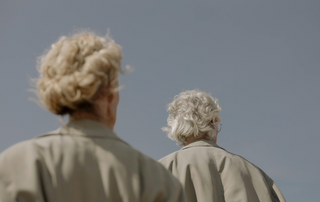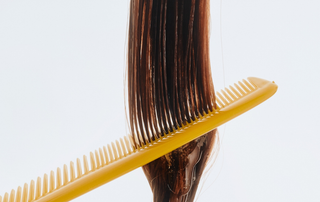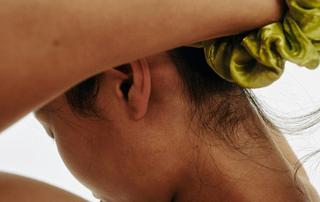If you've ever noticed flakes on your shoulders or experienced an itchy head, you may have a scalp condition. But while dandruff is the most common scalp issue, you could actually be dealing with seborrhoeic dermatitis, which is a more severe and persistent form.
Although dandruff and seborrhoeic dermatitis share similar symptoms, they tend to affect people in slightly different ways. Therefore, understanding the differences between the two is the first step toward managing either condition effectively. Choosing a licenced medicated product like Polytar Scalp Shampoo can make all the difference, too.
In this blog, we’ll break down the key differences between dandruff and seborrhoeic dermatitis and explain how Polytar can help.
What is dandruff?
Dandruff is a mild and common scalp condition that causes white or yellowish flakes on the scalp. It’s usually not serious nor contagious, but it can be frustrating and sometimes even embarrassing. The good news is it’s treatable with a medicated coal tar shampoo such as Polytar.
What are the main symptoms of dandruff?
Dandruff often appears during adolescence or early adulthood and may come and go if the scalp is exposed to triggers. Men are most commonly affected, but anyone can experience dandruff at some stage of their lives. It also tends to fluctuate as the seasons and stress levels change.
These are some of the main symptoms of dandruff:
Dry dandruff
- Appearance: Small, fine, white or greyish flakes that fall from the scalp, often visible on dark clothing.
- Texture: Light and dry. Flakes are loose and not stuck to the scalp.
- Cause: Usually due to dry skin, particularly in colder months or from excessive washing with harsh shampoos.
- Scalp condition: May feel tight, itchy or slightly irritated, but rarely oily.
- Common in: Males, people with dry skin, or those experiencing stress and certain health conditions.
Oily dandruff
- Appearance: Larger, yellowish or white flakes that are greasy or sticky.
- Texture: Thick and clumpy. Flakes often adhere to the scalp and hair strands.
- Cause: Triggered by excess sebum (oil) production, often linked to seborrheic dermatitis, and may involve overgrowth of Malassezia yeast.
- Scalp condition: Oily, inflamed, and sometimes red or itchy.
- Common in: People with oily skin or underlying skin conditions like scalp psoriasis or dermatitis.
What causes dandruff?
Most people believe that poor hygiene is often to blame for dandruff, but the real cause can be more varied and complex. These are the main reasons for dandruff:
- Malassezia overgrowth
- Stress and hormonal changes
- Dry skin
- Trapped heat and moisture caused by headgear
- Hair products containing alcohol, strong detergents, and artificial fragrances
- Residue build-up
- Infrequent washing
- A diet lacking in zinc, B vitamins, and essential fatty acids
- Allergies
What is seborrhoeic dermatitis?
Seborrhoeic dermatitis is a chronic inflammatory skin condition that affects the scalp and other areas of the body that are rich in oil glands. This can include areas around the hairline, nose, eyebrows and behind the ears.
What are the main symptoms of seborrhoeic dermatitis?
Seborrhoeic dermatitis is a persistent condition where symptoms may improve temporarily, then flare up again. Sufferers often experience:
- White or yellowish flakes
- Red, irritated skin
- Crusty blisters that sometimes ooze
- Persistent itchiness
- Thickened skin
- Inflammation
- A greasy scalp due to excessive oil production
- Temporary hair loss or thinning (rare)
What causes seborrhoeic dermatitis?
The exact causes of seborrhoeic dermatitis are not fully understood, but the condition is thought to have a number of triggers. In particular, some people notice their symptoms get worse when they are stressed or unwell. Other causes include:
- Malassezia yeast overgrowth
- Overactive sebaceous (oil) gland
- A hypersensitive immune response to the yeast or oil
- The use of strong detergents
- Being outside in cold, dry weather
- Being in the sun for too long
- Alcohol-based skin products
- Infections
What are the differences between dandruff and seborrhoeic dermatitis?
At first, dandruff and seborrhoeic dermatitis can seem almost identical. Both conditions involve flakes, itching and general scalp discomfort. However, dandruff is a milder condition of seborrheic dermatitis that causes small, white or yellowish flakes to fall/shed from the scalp. The scalp itself usually looks normal and doesn’t experience any redness or swelling. It might feel a little itchy or dry, but it’s generally not painful or inflamed.
In contrast, seborrhoeic dermatitis is more serious and often feels more uncomfortable. The flakes are larger and greasier than dandruff flakes, but the skin also tends to be red, irritated and oily. This inflammation can make the scalp feel sore and even burn slightly.
Another key difference is in the location of the symptoms. Dandruff usually only affects the scalp, while seborrhoeic dermatitis often spreads to other oily areas of the body, like the eyebrows, the sides of the nose, behind the ears and even on the back and chest.
While both conditions are linked to an overgrowth of a natural yeast called Malassezia, seborrhoeic dermatitis also involves a stronger immune reaction and more oil production, which is why it tends to flare up and come back over time.
Dandruff can usually be managed with regular anti-dandruff shampoos, but seborrhoeic dermatitis usually needs medicated treatments and sometimes ongoing care to keep it under control.
How medicated shampoo like Polytar can help treat dandruff and seborrhoeic dermatitis
Medicated shampoos are effective in the treatment of dandruff and seborrhoeic dermatitis. Polytar Scalp Shampoo is a licenced medicated shampoo that works to actively treat the symptoms of common scalp conditions thanks to Coal Tar Solution 4% – a proven active ingredient that helps relieve itching, reduce scaling and calm inflammation. It’s also:
Anti-inflammatory
Reduces redness, swelling, and irritation from scalp conditions.
Antiseptic
Cleanses the scalp and helps prevent infection.
Keratolytic
Breaks down excess keratin to reduce thickened, scaly skin.
Antipruritic
Soothes the scalp to relieve persistent itching.
Exfoliating
Promotes natural shedding of dead skin cells to reduce build up and dryness.







